Miracle of Magnets
The practical experiences with magnets unfortunately had negative effects for theories, not only of electro-technology and physics, but also concerning the general thinking-by-opposites. Magnets show clearly two poles and this dualism was raised to a general valid principle. It´s assumed the existence of like und unlike stuff, attraction and rejection, plus and minus, all times just-likely this and just-opposite, a perfect symmetry e.g. by particles and anti-particles, up to super-symmetries - until finally to realize, just the ´system-violations´ respective asymmetries arise the most interesting results. The common polarized thinking is too simple, too mechanical, too mathematical for the reality. There are no contrary extremes, there is only a more-or-less with smooth transition.
As an example, I was searching - many months and fruitless - for a pattern of aether-movements which would result a perfect sphere (e.g. because it´s well known, the atoms are sphere-shaped objects). Finally when I was free to accept bumps and dents and pulsating swinging motions, I found solutions for that problem and unforeseen multiple motion-pattern in addition. Now here however the aether-movements are asked, which allow the appearances of magnetism.
Inner Magnet-Flow
All neighbouring aether must behave analogue. If that left-turning forward-motion exists within the material at the south-pole, also the Free Aether in front of the south-pole is stimulated to swing adequate. There exists a ´suction-effect´ like at gases and fluids. These motion-structures within a ´tube´ are also spreading backward. That´s marked here by three blue arrows left side of south-pole. Analogue the motion-pattern does not end at the surface of the north-pole. There exists the same motion-pattern, i.e. also the movements of the Free Aether in front of the north-pole will take that ordered structure.
Outer Magnet-Backflow
That external back-flow is marked at the second row of this picture by the blue arrow B. Into direction of the flow (thus here from the north- to the south-pole) that left-turn is unchanged. Right side at the cross-sectional view, this turning movement is marked by the circle-arrow C. By that view onto the south-pole (thus contrary to the external flow-direction) that swinging movement appears right-turning.
At this picture only one thick blue arrow is drawn representing many ´magnetfieldlines´ (which theoretic exist within all spaces of the material grid). Also the external back-flow here is marked by only two thick blue arrows. At reality, many most thin magnetfieldlines are running through the aether from north-pole back to the south-pole. Thus all around the longitudinal sides of the magnet-rod exists an area of back-flow. Right side at the cross-sectional view, this area is marked by a green ring. All aetherpoints of this region are swinging parallel to each other, all left-turning into flow-direction. As a whole, this common swinging of numberless aetherpoints results the appearance of a general turning movements around the outer faces of the magnet-rod. The turning-sense is left-turning into flow-direction. By view into opposite direction, here viewing at the south-pole, that motion appears as a general right-turn.
Transit-Flow
The magnetic flow of the left magnet-rod is moving to the right magnet-rod, where its left-turning is unchanged. Here is drawn a rod of iron (FE, grey) between both magnets and the magnetic flow is also running straight through this material. The internal structure of iron can adapt the magnetic motion-structure, also alternating in both direction (as discussed some later).
Pushing instead of Pulling
As often mentioned here, the Free Aether affects a general pressure onto all wide-ordered movements, thus also against this well structured magnetic flow. Within the magnet-rods and also within previous iron, that motion-pattern is protected. Also at that gap E, the Free Aether can not act disturbing, e.g. because the magnetic backflow exists all around that area. The general aether-pressure can show effects only at the open faces left and right side. So the magnetic field-lines are compressed from both sides. The material of the magnet-rods follow that pressure and thus they move closer, like marked by the black arrows F.
Shifting off
Both flows affect mutual pressure, like marked by black arrows G. The flow is ´dammed up´ and the material of both magnet-rods move back correspondingly. Only that balancing maneuver reduces the stress. Only by sufficient distance between both like poles, the magnetfieldlines can flow back to their south-poles unhindered.
It´s ever astonishing, one can not completely press together the like poles of two magnet-rods by hands. Even harder to believe for many readers might appear, these strong forces are affected by that invisible aether-medium. As an answer only remains: what else? All forces finally are aether-movements. Just because the aether is individable and only one gapless substance, that absolute necessity of certain processes exists. Naturally it´s common understanding, these effects are based on ´magnetic or electric fields´ - however how could abstract ´fields´ result real effects? Just for previous example of ´attracting forces´ even no theoretic model for that function exists, especially as it should work through the ´nothing of vacuum´. The usual ideas and explanations are insufficient, no matter how often they are repeated and proclaimed. Aether is a totally real substance and certain movements within result firm results.
Different Forces
The real aether-movements however are most different and thus also the resulting forces. At the case of ´attraction´ the magnets are pushed together from their ends by the general aether pressure. At the case of ´rejection´ exists a much stronger necessity, caused by the contrary flows between like poles. So stress comes up within the aether and the relaxation of tensions is inevitable demanded. Finally appear huge forces because the aether can not be ´bended´ above a certain limit.
Thus the forces between like poles are much stronger than between unlike poles. The effect between two north-poles differs to the situation between two south-poles. The ´magnetic flow´ is forced to exit the face of a north-pole and each magnetfieldline at its location. A south-pole is ´sucking-in´ that motion-pattern - however this is not urgent by same necessity. The south-pole can ´pull-in´ also at faces aside or this motion must not be formed totally exact at the ´beginning´ of the magnet-rod. So one may not simply follow cross-the-board formula for searching and developing aether-conform solutions.
Magnets via Current
If an iron-rod (FE, grey) is added in the inner magnetic field, the field-lines are running through the iron. While the current is running, the iron-particles (by parts) become oriented according to the magnetic field. The magnetization of the coil-core schematic is sketched at this picture below left at C. The magnetization is not permanent. If the coil is driven by alternating current AC, the direction of current changes periodical and thus also the magnetic field.
Finally if a strong direct current DC (thick black arrow, right side at D) is pressed through the coil, the orientation of the iron-particles is fixed so strong, a permanent magnetization is achieved. Normally not all particles are perfectly ordered. So the magnetic fields at the poles indeed exist by separated ´magnetfieldlines´. Permanent-magnets build by material of ´rare earths´ are stronger by hundreds. There the magnetic flow might spread really the whole face, i.e. all aether there might swing parallel to each other in total.
Coupling Space-Energy
The term ´energy´ is used by so much meanings, so by itself got lost any meaning. At subjects of physics one can replace ´energy´ by the term ´motion´ - and as only the aether really exists, energy is nothing else than aether-motion. Really all the aether is permanent moving, so unlimited energy exists. Because the aether is a gapless substance, the motions never can come to a standstill. However the chaotic narrow motions of Free Aether are without effects (besides the resulting permanent general pressure affecting onto all well structured motion-units and thus e.g. stabilizing electrons and atoms, and Free Aether naturally is involved in electric appearances).
In general however, usable forces can come up finally from an ordered aether-motion. At natural magnets the internal structure of the material (by chance) produces an ordered motion in shape of the magnetic field. The general motion-pattern is that ´forward-and-left´. Combined with iron-parts or other magnets automatic come up these force-effects which commonly are called attraction respective repulsion. As discussed upside, the real cause however is the general aether-pressure onto ordered motion-pattern, here onto the magnetic fields.
The force-effects of ordered aether-movement occur not only at these small magnets. The structured forces in principle are working infinite long - just because the movements of aether can not be stopped. For example, the whirlpool of the sun permanently performs a centripetal force (against the centrifugal force) and for millions of years thus the earth is drifting around the sun. However the structure of aether-motions can be disturbed (e.g. by comets or at magnets by heat). At the other hand, one can organize well structured aether-motions, e.g. by previous magnetization or as later chapters might show. By sure, the result will not be a Perpetuum Mobile - because the energy of aether is omnipresent and generating usable forces demands only a skilled organization.
Remark: Magnetic Field left-turning
It´s well known, the electric current induced a left-directed magnetic field. Just this is applied at previous magnetization. So the particles must adjust accordingly at the production of synthetic magnets. A natural permanent-magnet shows same effects like a magnet-field produced via current. Thus also the motion-pattern must be likely: ´into drive-direction left-turning´.
No wide Flow but narrow Swinging
Analogue is the situation at the ´magnetic flow´, where in reality nothing is moving forward. Opposite: this motion-patters ´stands stationary´ between the magnet poles. It exists inside the material respective within the core of previous coils. It exists between the poles of magnets and also the magnetfieldlines stand like shells along the outside faces of magnets. At picture 09.06.03 is drawn a section of the magnet field within free space between the surfaces of a north-pole (N, blue) and a south-pole (S, red).
There are marked seven aetherpoints (black) upside each other and each two neighbouring aetherpoints aside. All points are swinging parallel to each other, each at its circle-track, each left-turning. In order to achieve a local balance of aether-volumes, the points from bottom up are ´time-shifted´. The points most upside and most down momentary are at the background (respective at their 12-o´clock-position). The point at the middle row momentary are at the foreground (respective at the 6-o´clock-position). The points between are each shifted by 60 degree.
The connecting-line between vertical points builds a spiral curve. Like the points are only turning around at their level, the connecting-lines are simply turning within the space between north- and south-pole. Nevertheless the impression comes up, anything is spiral-upward moving. This ´seeming appearance´ corresponds to the direction of magnetic flow: coming out of the face of the north-pole and wandering into the face of the south-pole, like here marked by the blue arrow.
Thrust-Effect
Each aetherpoint of its circle-track ´pushes´ its sideward neighbours in each corresponding direction. The aetherpoints at the middle level of previous picture 09.06.03 are momentary at the foreground (6-o´clock) and are moving further right side. If aetherpoints of an other motion-unit (e.g. of an electron or a material particle) exist at the right side, they are affected by some thrust toward right side. The aetherpoints at the level upside of, come some later at this position and thus also their pushing impulse. As a whole, that ´foreign body´ is affected by a diagonal-upward thrust.
Upside right at B is drawn a grey conductor, where a ´current is flowing´ from minus to plus. Therefore comes up a magnetic environment (light-green) with movements practically identical with previous magnetfield-pattern: forward into current-direction and left-turning, like marked by the spiral curve. Below right at D again a section is drawn and the movements are running analogue to the previous ones: a left-turn combined with a forward-motion (see thick red arrows). Again a thrust-affect could result (see dotted red curve) onto ´foreign bodies´.
Similar however different
Many electrons there are moving into likely direction and they leave a trace within the aether. Within the tube-shaped ´slides´ they become transferred into a common swinging, which occasional is called ´space-charge´ or even a ´plasma´. When the lightning strikes the ground, that mixture of extreme motions produces the ´electric charge´ which is spread over the ground all around by the general aether-pressure.
The characteristic of charge respective static electricity are vortex-spindles, standing and swinging parallel besides each other, showing from the surface outward. This ´electric field´ sticks at a material surface respective this ordered flat motion-pattern is pressed on the face by the general aether-pressure. Nevertheless weak extensions of the vortex-spindles reach far out into the space. The ´stationary´ charges with their internal movements practically build an energy-stock, e.g. also to store temporary by a capacitor (see later chapters).
The electric current is also based on vortex-spindles, which however are directed along a conductor surface. They are swinging within a relative small ring-shaped area between the outside atoms of the conductor, mostly however within the common aura-shell around the conductor, and the atoms of any isolator-cover. These thin spindles can easy move in longitudinal direction, because at front sides the general swinging of the aether must increase to a wider radius only by minimum size (and the rear ends of the spindles are shifted forward by the Free Aether). This flow can be generated (see following chapter), it can be dammed-up (by any kind of switch), finally it can be ´consumed´ (in order to achieve certain usage), can flow back to the generator or into the ground. This current can flow along conductors by separated impulses, also in alternating direction. When using DC, the separated spindles can ´melt to endless long threads´.
Only that ´flowing´ results electro-magnetism, as the swinging of electric current by itself generates a common outside motion around the conductor. This aura is the ´induced magnetic field´. The ´electric field´ is forward directed and only that narrow ring-shaped area of the original current-motion is involved by these thin vortex-spindles. Even that movement is most intensive, it is bound narrow to the conductor. It´s not dangerous to manually hole e.g. a 220 V wire which is covered by only millimeter-thin isolator.
Quite different behaves the induced magnetic field, as it reaches far out into the environment. Obviously that swinging-pattern can penetrate the isolation and also other materials - and practically no protection exists against the magnetic fields. So around a ´live´ conductor inevitably exists a magnetfield all around. This field accompanies the current-impulse along the conductor. The magnetic flow can be concentrated, e.g. at the core of previous coil (later discussed in details). The generated magnetic field decreases as soon as the current is stopped.
The motion-pattern keeps constant at permanent magnets. Here also the pattern keeps stationary, it´s practically ´anchored´ at the surfaces of poles (or iron-parts between, and also within the core of coils). So the movement-pattern of natural magnets, permanent magnets or magnetism induced by current are rather similar. The important difference exists on the bond: at the one hand onto the material, at the other hand at the flow of a current. Next chapter will show some interactions between both appearances.
For young people the world is full of miracles. Most wonders lose the magic later on, however some remain unsolved till the end. The sciences present explanations, however many still remain ´wondrous´. The first experience with a compass is such a wonder: why does the needle show northwards all times, like being controlled by an invisible force? Later on one learns the compass is a small magnet-rod and the earth functions like a huge magnet-rod because embedded within a magnetic field and the geographic north-pole is a magnetic south-pole. Wondrously it´s still a riddle how that could function with a red-hot iron core. However that´s not relevant here respective that ´friction-magnetism´ (analog to previous ´friction-electricity´) is explained at earlier chapter 08.17. ´Aethervortex of Earth´.
At picture 09.06.01 upside at A a magnet-rod is drawn by longitudinal cross-sectional view, with its south-pole (S, red) and its north-pole (N, blue). The atoms of permanent-magnets are arranged by grids. So the aether-movements at the aura of atoms and at the spaces between the atoms are also ordered. These structures result an internal ´magnetic flow´ which generally is directed from the south- to the north-pole (marked by thick blue arrow). There are good reasons for the assumption, that flow follows also previous rule ´in-drive-direction-left-turning´ (marked by the black circle-arrows). The track of that movement thus is comparable with a left-turning staircase. Upside right is sketched a corresponding cross-section view at the south-pole.
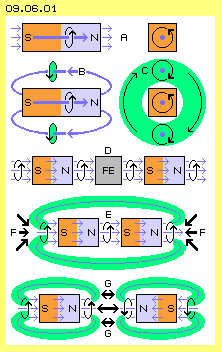 A permanent-magnet indeed is comparable with a pump with simple blades, which is running counter-clockwise within a water-tank. At the inlet (south-pole) water is sucked in. Already some further back the flow starts ´twisting´. At the outlet (north-pole) that motion-pattern is pushed off. The ambient water (respective Free Aether) represents a resistance against these ordered movements. The ´jet´ is redirected aside. At the south-pole a similar motion exists - and both flows as a whole build a perfect circuit.
A permanent-magnet indeed is comparable with a pump with simple blades, which is running counter-clockwise within a water-tank. At the inlet (south-pole) water is sucked in. Already some further back the flow starts ´twisting´. At the outlet (north-pole) that motion-pattern is pushed off. The ambient water (respective Free Aether) represents a resistance against these ordered movements. The ´jet´ is redirected aside. At the south-pole a similar motion exists - and both flows as a whole build a perfect circuit.
An ordered flow within the gapless aether automatically forces neighbouring aetherpoints to move adequate. The ordered movement spreads into that direction, where the aether can take that motion-structure. At previous backflow this is the outside way from north- back to south-pole. Even simpler is the straight way from a north-pole to the south-pole of a second magnet-rod. This arrangement is sketched at third row of that picture at D.
At the following row E, both magnet-rods are positioned close to each other. The areas of the external backflow from north-pole right to the south-pole left is marked light-green. At the middle meet a north- and a south-pole. By common understanding now an attracting force comes up between these unlike poles - however common sciences can not offer any explanation for this function.
At the row below at this picture 09.06.01 the opposite situation is drawn. Here both north-poles of both magnet-rods meet at the middle. Like at previous example, also here the general aether-pressure is affecting at both sides and try to move together both rods. Much stronger however than the general aether-pressure is the effect of stress. Already before the bend-abilities of aether is strained to its maximum, inevitably must come up balancing movements to reduce the tensions. Here the aether is strong tensioned, because magnetic flows exit from both north-poles, thus in contrary directions and in addition the turning sense of both motions is conflicting.
Since no concrete ideas for the function of aether-movements exist, commonly one simply works and calculates by abstract model of ´fields´. For example the magnetic fields between a north- and a south-pole are suggested to be homogenous. The attraction and rejection are assumed to be functions of these fields, so same forces with opposite vectors.
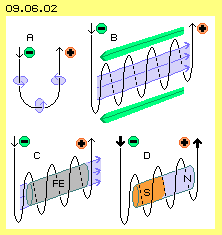 At picture 09.06.02 upside left at A, a U-shaped conductor is drawn, where direct current DC is running form minus to plus. Around the conductor exists a left-turning motion as the result of ´magnetic induction´, marked by the blue circle-arrows. The conductor can also build loops, resulting a coil like sketched upside right at B. Looking into direction of the current, the coil is winded left-turning. All left-turning motion inside of the coil result a magnetic flow, which here is directed from left to right side (marked light-blue, see dark-blue arrows). Analogue to previous magnet-rod, magnetfieldlines are directed back outside around the coil (marked light-green, see dark-green arrows).
At picture 09.06.02 upside left at A, a U-shaped conductor is drawn, where direct current DC is running form minus to plus. Around the conductor exists a left-turning motion as the result of ´magnetic induction´, marked by the blue circle-arrows. The conductor can also build loops, resulting a coil like sketched upside right at B. Looking into direction of the current, the coil is winded left-turning. All left-turning motion inside of the coil result a magnetic flow, which here is directed from left to right side (marked light-blue, see dark-blue arrows). Analogue to previous magnet-rod, magnetfieldlines are directed back outside around the coil (marked light-green, see dark-green arrows).
Over and over again it´s discussed, whether a permanent magnet is a ´perpetuum mobile´. For example, previous magnetization needs strong DC only for short moment and the generated permanent magnet provides forces ´lifelong´. The law of energy-constant seemingly is injured. So it´s suggested, the magnets would tap any kind of ´space-energy´.
An important remark in ´own concern´: in some earlier chapters I wrote, the magnetic field might be right-turning. At these times I assumed all aether would be left-turning in general. A magnetic field has effects only within a limited area and magnetfieldlines are pressed back at most short way. So I deduced the left-turning aether compresses and even eliminates the right-turning fieldlines. This was wrong.
Terms like ´flow, flowing, running ´ etc. were often used at previous descriptions of aether-movements and the behavior of aether was compared with gases and fluids. The real movements of the real aether however are bound to other necessities. The aether is gapless and anywhere of likely density. Aether can not move far distances. It can only swing at relative narrow space. Above this it´s necessary, one locale shifting of aether is compensated by a contrary movement, e.g. like both layers of a ´double-crank´ function. Motion-units are only stabile, if all mutual removals perfectly fit, like e.g. by that synchronous swinging all around of the sphere-shaped electron.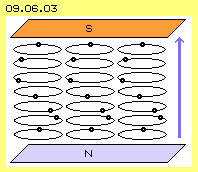 Like shown upside, photons are racing through the space by light-speed. However no ´particles´ nor aether are running through the universe. Only the motion-structure is forwarded within the (nearby stationary) aether. Like this, e.g. also the ´spindle-pattern´ of electric current wanders along the surface of a conductor. Or these ´vortex-spindles´ of charge stand stationary and upright swinging above a surface.
Like shown upside, photons are racing through the space by light-speed. However no ´particles´ nor aether are running through the universe. Only the motion-structure is forwarded within the (nearby stationary) aether. Like this, e.g. also the ´spindle-pattern´ of electric current wanders along the surface of a conductor. Or these ´vortex-spindles´ of charge stand stationary and upright swinging above a surface.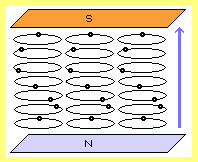 The motion-process is visualized by this animation - which at first might look even confusing. When looking concentrated at one point, obviously it´s only circling at its round track. All neighbours aside are swinging parallel. Also at the vertical direction, all points are swinging by likely speed. From bottom up, they are only some later at their tracks.
The motion-process is visualized by this animation - which at first might look even confusing. When looking concentrated at one point, obviously it´s only circling at its round track. All neighbours aside are swinging parallel. Also at the vertical direction, all points are swinging by likely speed. From bottom up, they are only some later at their tracks.
The upward-movement of the spiral does not exist really. This is only the visual result of time-shifted swinging at different levels. Nevertheless a real affect can come up, if other motion-units enter this area of stabile motion-pattern.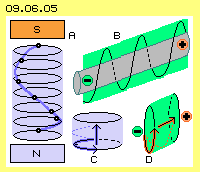 At picture 09.06.05 left at A the swinging of the aetherpoints of a ´magnetfieldline´ is shown once more. Here is also drawn the vertical connecting-line in shape of that blue spiral. Below at the middle at C, a section is drawn and the general left-turn and the seeming upward-motion are marked by blue arrows. The previous mentioned diagonal thrust is marked by blue dotted curve, which eventually could affect a ´foreign´ motion-pattern.
At picture 09.06.05 left at A the swinging of the aetherpoints of a ´magnetfieldline´ is shown once more. Here is also drawn the vertical connecting-line in shape of that blue spiral. Below at the middle at C, a section is drawn and the general left-turn and the seeming upward-motion are marked by blue arrows. The previous mentioned diagonal thrust is marked by blue dotted curve, which eventually could affect a ´foreign´ motion-pattern.
So at subject of electro-magnetism are combined two appearances of similar motion-pattern. But still exist grave differences. An electron is a basic unit of electricity. It´s a sphere-shaped complex of aether-vortices, which are rather stabile as a whole. Towards outside the electron has an aura of balancing motions to the Free Aether, thus is enclosed within an ´electric flied´. Electrons are easy to produce, like upside example of the velvet-carpet did show. They are generated in huge numbers e.g. by ´friction-electricity´ at storm-clouds.
09.07. Magnet and Current
09. Aether-Elektro-Technics